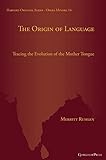The Origin of Language : Tracing the Evolution of the Mother Tongue / Merritt Ruhlen.
Material type: TextSeries: Harvard Oriental Series - Opera Minora ; 14Publisher: Piscataway, NJ : Gorgias Press, [2023]Copyright date: ©2023Description: 1 online resource (319 p.)Content type:
TextSeries: Harvard Oriental Series - Opera Minora ; 14Publisher: Piscataway, NJ : Gorgias Press, [2023]Copyright date: ©2023Description: 1 online resource (319 p.)Content type: - 9781463244958
- 9781463244965
- 401 23//eng/20230501eng
- online - DeGruyter
| Item type | Current library | Call number | URL | Status | Notes | Barcode | |
|---|---|---|---|---|---|---|---|
 eBook
eBook
|
Biblioteca "Angelicum" Pont. Univ. S.Tommaso d'Aquino Nuvola online | online - DeGruyter (Browse shelf(Opens below)) | Online access | Not for loan (Accesso limitato) | Accesso per gli utenti autorizzati / Access for authorized users | (dgr)9781463244965 |
Frontmatter -- Preface 2010 -- Preface 1994 -- Contents -- Prologue: What Do We Mean by the Origin of Language? -- 1 Language and History: Voices from the Past -- 2 Language Families: What is Known -- 3 Controversy: What is Debated -- 4 Native Americans: Language in the New World -- 5 The Origin of Language: Are There Global Cognates? -- 6 A Window on the World: What Has Been Resolved -- 7 Genes: Biology and Language -- 8 The Emerging Synthesis: On the Origin of Modern Humans -- Epilogue: Reconstruction, Sound Correspondences, and Homelands -- An Annotated Bibliography -- Appendices -- Index
restricted access online access with authorization star
http://purl.org/coar/access_right/c_16ec
This book, The Origin of Language: Tracing the Evolution of the Mother Tongue, originally published in 1994 by John Wiley & Sons, was written in a more popular style, accessible to an educated general audience, than the more scholarly and academic tome of a similar title, On the Origin of Languages: Studies in Linguistic Taxonomy, published the same year. In The Origin of Language Ruhlen laid out the principles of linguistic genetic classification, i.e., classifying languages into families according to common origins rather than typological features. Ruhlen showed how simple this can be, especially for languages that have diverged for a few millennia, by juxtaposing short lists of basic (non-cultural) words like eye, fire, and tongue. He also showed that the same methods can be used to postulate older and deeper families, often called “macro-families” or “macrophyla,” by comparing reconstructed forms from lower-level families. Such deeper families (e.g., Nostratic, Dene-Caucasian, Nilo-Saharan, Austric) are generally more controversial than lower-level families, but Ruhlen did not shy from discussing them if he thought the evidence supported them. Ruhlen was also interested in other fields of anthropology, such as archaeology and human genetics, and brought these fields into play.
Mode of access: Internet via World Wide Web.
In English.
Description based on online resource; title from PDF title page (publisher's Web site, viewed 25. Jun 2024)


